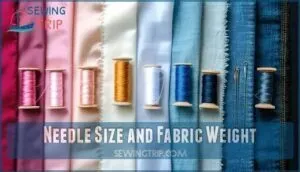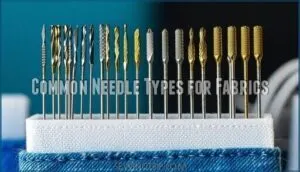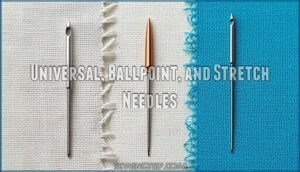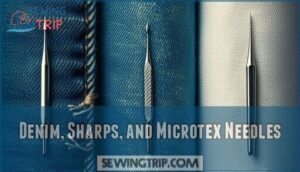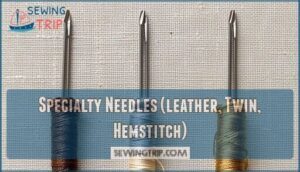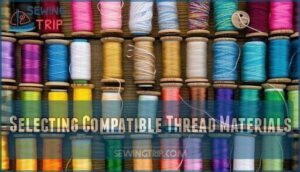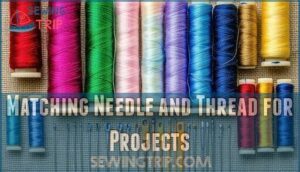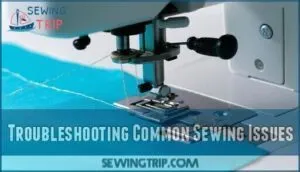This site is supported by our readers. We may earn a commission, at no cost to you, if you purchase through links.
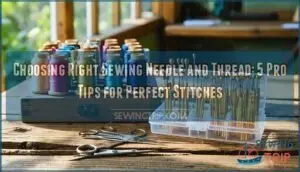
Match fine thread with smaller needles and thicker thread with sturdier ones—no one likes a mismatched team. Polyester thread wins in strength, but cotton’s a classic for natural fabrics.
Adjust tension, mind your machine, and treat your gear well. Stick with these basics, and your stitches will thank you—just wait until you see tip number five.
Table Of Contents
Key Takeaways
- Match your needle size and type to the fabric weight and texture so you won’t face skipped stitches or damage.
- Pair your thread weight with the right needle: fine threads need smaller needles, and thick threads need sturdier ones.
- Don’t forget to check both your needle and thread material compatibility—polyester’s tough, but cotton pairs best with natural fabrics.
- Change your needle when you notice skipped stitches, snags, or a rough tip; safe disposal keeps your workspace tidy.
Choosing The Right Needle for Your Fabric
You’ll save time and prevent frustration by matching your needle to your fabric’s weight and texture. A lightweight cotton needs a size 75/11 needle, while heavy denim requires a 110/18 to punch through without breaking or skipping stitches.
Needle Size and Fabric Weight
Your needle size guide starts with one simple rule: match needle size to fabric weight. Lightweight fabrics like silk need thin needles (70/10-75/11), while heavy denim requires strong needles (100/16-110/18). Medium fabrics work with 80/12-90/14 needles.
This fabric thickness guide prevents damage and ensures smooth stitching. Thread size match matters too—pair fine threads with small needle point types, and heavier threads with larger ones.
Common Needle Types for Fabrics
Not all sewing machine needles are created equal—some just work better on certain fabrics. Universal needles can handle most projects, but if you’re working with knits, ballpoint needles are your friend because they help prevent snags.
For dense, heavy fabrics, sharp needles glide through cleanly, and if you’re sewing thick materials like denim, reach for those specialty needles made to handle the extra stress.
Needle point shapes affect stitch quality—eye size matters for thread compatibility. Choose needle types based on your fabric’s weight and weave to avoid needle breaks. Selecting the correct needle is essential, and you can find more information on different needle types.
Understanding Sewing Needle Types
You’ll encounter several needle types in your sewing toolkit, and each one has a specific purpose that can make or break your project.
Choosing the wrong needle type is like using a butter knife to cut steak—it’ll work, but you won’t get clean results.
Universal, Ballpoint, and Stretch Needles
Now that you’ve considered fabric weight, let’s explore three needle types that’ll cover most of your sewing projects. These needles differ in their point shapes and applications:
- Universal Needle – Your go-to choice for woven fabrics like cotton, linen, and polyester blends
- Ballpoint – Features a rounded tip that slides between knit fabric fibers without cutting them
- Stretch Needle – Has a deeper scarf design for highly elastic materials like lycra and spandex
- Needle Point Shapes – Determine how the needle penetrates different fabric structures
Universal needle uses span most general sewing tasks, while stretch needle applications focus on activewear and swimwear.
Denim, Sharps, and Microtex Needles
Heavy-duty projects call for tougher solutions. Denim needles feature reinforced shafts and sharp points that power through thick layers without bending. Sharps needles offer precision for woven fabrics, while Microtex needles slice cleanly through delicate materials like silk.
Every needle is made for a specific kind of project, with a tip shape that matches the job—so your stitches stay strong and your thread glides smoothly.
| Needle Type | Best Applications |
|---|---|
| Denim | Heavy fabrics, topstitching, canvas |
| Sharps | Woven cottons, precise piecing |
| Microtex | Silk, microfiber, dense weaves |
| Denim Guide | Sizes 90/14 to 110/18 recommended |
| Sharp Applications | Medium to heavy weight projects |
Specialty Needles (leather, Twin, Hemstitch)
Beyond basic needles, specialty options tackle unique projects. Leather needles feature triangular tips that pierce thick materials without tearing. Twin needle uses include creating professional hems and decorative stitching on stretch fabrics. Hemstitch needles produce delicate openwork patterns.
A good specialty needle guide should walk you through the different sewing machine needle types and sizes you’ll need for these more advanced techniques.
Selecting Compatible Thread Materials
You’ll face frustration and weak seams if you don’t match your thread material to your fabric type and weight.
Thread compatibility affects stitch quality, durability, and overall project success, so understanding polyester, cotton, nylon, and specialty options helps you avoid common sewing problems.
Polyester, Cotton, Nylon, and Linen Threads
After selecting your needle type, choosing the right thread material determines your project’s success. Each thread material brings unique Thread Material Properties that affect durability and appearance.
Understanding the differences helps in selecting the right thread for each project. Thread and needle compatibility affects stitch quality a lot.
- Polyester Thread – Offers 30% higher strength than cotton, helps with high-speed sewing, and provides excellent Thread Colorfastness
- Cotton Thread – Creates smooth seams on natural fabrics, biodegradable option among Eco-Friendly Threads
- Nylon Thread – Delivers notable abrasion resistance, 16-17% stretch for flexibility in Thread Strength Comparison
- Linen Thread – Combines tradition with durability, moisture-absorbing properties for specialized applications
Thread Thickness and Fabric Compatibility
When choosing thread for your projects, match thread weight to fabric density using a Thread Weight Guide. Lighter fabrics need fine threads, while heavy materials require thick ones.
Thread Fiber Blends affect compatibility—check Fabric Thread Density before starting. Consider Stitching Stress Points and Specialty Thread Finishes for durability.
Proper needle and thread compatibility prevents skipped stitches.
Waxed Threads for Hand-sewing Leather
When handsewing leather, waxed thread becomes your best friend. Waxing benefits include smoother passage through thick leather and enhanced stitch durability. The wax coating prevents fraying while improving knot security.
Choose thread thickness based on leather compatibility – thicker threads for heavy leather, finer for delicate work. Your thread and needle size guide should match leather thickness for professional results.
Matching Needle and Thread for Projects
You can’t just grab any needle and thread combo and hope for the best. The right pairing creates smooth stitches, prevents fabric damage, and saves you from fixing mistakes later.
Pairing Needle Size With Thread Weight
When needle gauge doesn’t match thread weight, you’ll face thread breakage that can ruin your project. The needle eye size must accommodate the thread thickness without creating loose stitches, which would compromise the stitch appearance.
Using this thread size guide helps you avoid issues that come from mismatched fabric and thread thickness. Before you get started, just double-check a needle guide to be sure your choices are compatible.
- Size 70/10 needles pair with fine threads (40-60 weight) for lightweight fabrics
- Size 80/12 needles work with medium threads (30-40 weight) for everyday sewing
- Size 90/14 needles handle heavier threads (20-30 weight) for quilting projects
- Size 100/16 needles accommodate thick threads (12-20 weight) for denim construction
- Size 110/18 needles accommodate heavy-duty threads (8-12 weight) for upholstery work
Choosing Combinations for Different Projects
Different sewing projects demand Project-Specific Combinations to achieve professional results.
For quilting, pair 80/12 universal needles with cotton thread to create perfect Fabric-Thread Synergy. Denim projects require 100/16 needles with polyester thread for durability. Knit garments need ballpoint needles and stretch thread for proper Thread-Needle Harmony.
The pairing you choose can change how you sew and really shape the way your finished project looks and feels.
Tips for Strong, Professional Stitches
Think of sewing like building a bridge—your stitch quality depends on strong parts working together.
Pick a sewing machine needle that matches thread size and fabric. Use proper Stitch Length for the project, adjust tension for smooth seams, and check Thread Quality.
Use Reinforcement Techniques at stress points, and don’t forget neat Seam Finishes for professional results.
Troubleshooting Common Sewing Issues
Sewing doesn’t always go as planned, but a few simple adjustments can solve most stitch problems.
If your project is giving you trouble, you’ll find quick fixes here to keep your fabric and thread working together smoothly.
Preventing Skipped Stitches and Fabric Damage
Ready to up your stitch quality? Nail your needle selection, and don’t forget these fixes when stitching gets tricky:
- Needle-Thread Tension—check it to stop skipped stitches.
- Use a stabilizer for slinky or stretchy fabric.
- Keep your machine maintenance on track for smooth, jam-free runs.
Watch for feed dog adjustment and needle plate choice—your fabric will thank you!
Adjusting for Thick or Delicate Materials
Thick denim and wispy silks each need a gentle approach—muscling through won’t help. Adjusting for fabric thickness keeps your stitches smooth and stops them from skipping.
Light-weight fabrics call for smaller needle size and delicate thread, while heftier materials need Needle selection suited for fabric weight and Thread Thickness.
Adjust Needle Tension Control and try Stitch Length Variation for smoother Delicate Fabric Handling.
Needle Care and Maintenance Tips
Keep your sewing sharp—literally! Take your needle care to the next level:
- Store needles in labeled cases to avoid mix-ups.
- Inspect for burrs by running a fingertip along the shaft.
- Clean with rubbing alcohol to prevent rust.
- Change needles after big projects—don’t push your luck.
- Dispose of old needles safely with other sewing supplies and accessories.
Frequently Asked Questions (FAQs)
How do I identify a dull sewing needle?
You’ll spot a dull sewing needle if it snags fabric, skips stitches, or feels rough when you drag the tip across your finger.
If needles make a “popping” sound, it’s time to swap them out.
Can needles be reused for different fabric types?
You can reuse sewing needles across fabric types, but it’s not always wise. Each project’s fabric wears down a needle differently, so switching can dull the point or snag threads. Think of it like mismatched dance partners.
What are signs my needle is incorrectly installed?
If your needle wiggles, skips stitches, or hits the throat plate, it may be installed wrong. You might hear odd clicking or see thread bunching. A backwards needle is a recipe for frustration.
Are color codes on needles industry standard?
You’ll notice color codes on many needle brands, but don’t take them as gospel. There’s no universal color standard, so always double-check your needle’s packaging or guide.
Colors make life easier, not foolproof.
How should I safely dispose of old sewing needles?
Drop bent or dull needles in a sealable, hard container like an empty prescription bottle—keeps fingers safe. When it’s full, toss it in the trash.
Simple habits like this save your vacuum (and your toes).
Conclusion
Like tuning an instrument, choosing the right sewing needle and thread sharpens your fabric work. Remember, match your needle size and thread thickness to the material—don’t force a skinny needle through tough denim or a thick thread on light cotton.
Pay attention to small details, and double-check for skipped stitches. With practice, you’ll avoid common mishaps and your machine will hum along. Precision and the right combo always lead to strong, neat results you can trust.
- https://corefabricstore.com/blogs/tips-and-resources/how-to-choose-the-perfect-machine-needle-for-your-next-sewing-project
- https://www.jjneedles.com/needles-guide
- https://www.sewjersey.com/blogs/quilting-tips/what-do-sewing-machine-needle-sizes-mean
- https://sewingmachineman.substack.com/p/how-the-relationship-between-the
- https://sewcanshe.com/2016-6-24-homemade-vs-handmade-4-kinds-of-thread-and-what-to-use-them-for/

